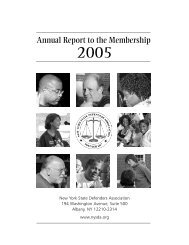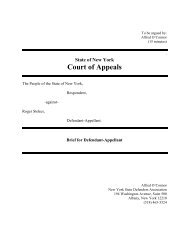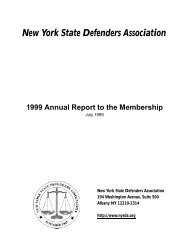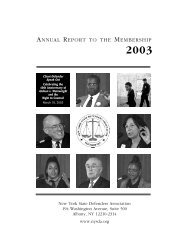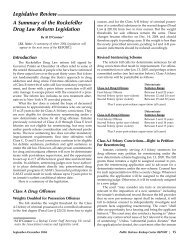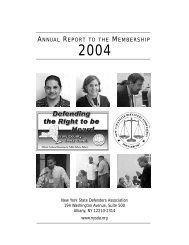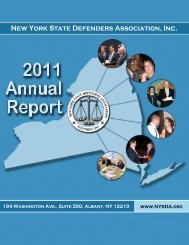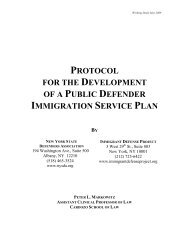Quick Reference Chart for Determining Immigration Consequences ...
Quick Reference Chart for Determining Immigration Consequences ...
Quick Reference Chart for Determining Immigration Consequences ...
Create successful ePaper yourself
Turn your PDF publications into a flip-book with our unique Google optimized e-Paper software.
APPENDIX A: QUICK REFERENCE CHART FOR DETERMINING IMMIGRATION CONSEQUENCES OF COMMON NEW YORK OFFENSES<br />
Offense<br />
Criminal<br />
impersonation,<br />
2nd degree<br />
Class A<br />
misdemeanor<br />
NYPL<br />
Section<br />
Aggravated<br />
Felony (AF)?<br />
190.25 If the loss to the<br />
victim(s)<br />
exceeds<br />
$10,000, might<br />
be “fraud or<br />
deceit” AF<br />
especially if<br />
record of<br />
conviction<br />
shows element<br />
of intent to<br />
defraud (as<br />
opposed to<br />
intent to obtain<br />
a benefit or to<br />
injure)<br />
Crime Involving<br />
Moral Turpitude<br />
(CIMT)?<br />
Other Grounds?:<br />
Controlled Substance (CSO)<br />
Crime Against Child (CAC)<br />
Dom. Violence (CODV) etc.<br />
Firearm Offense (FO)<br />
Prostitution<br />
Commercialized Vice<br />
Comments, Strategies & Tips<br />
These are by no means an exhaustive list of strategies and tips<br />
advocates may pursue. For additional defense lawyer strategies,<br />
see Chapter 5. For additional immigration lawyer strategies, see<br />
Appendix K.<br />
Probably. Tip <strong>for</strong> defense lawyers:<br />
1. To decrease “fraud” AF risk, specify in the plea<br />
colloquy that the loss amount did not exceed $10,000;<br />
and/or specify in plea colloquy that offense was<br />
committed with intent to obtain a benefit or to injure (as<br />
opposed to with intent to defraud). See Valansi v.<br />
Ashcroft, 278 F.3d 203 (3d Cir. 2002).<br />
2. To decrease CIMT risk, consider alternative<br />
offenses such as Disorderly Conduct (see below, PL<br />
240.20), Trespass (see above, PL, 140.05). If these are<br />
not possible, consider alternative offenses that may<br />
preserve the potential argument that the conviction is not<br />
a CIMT, such as Offering a False Instrument <strong>for</strong> Filing,<br />
2 nd (see below, PL 175.30) or Making a Punishable False<br />
Written Statement (see below, PL 210.45). If these are<br />
not possible and if client has no prior CIMT, consider<br />
alternative offense of attempt (PL 110.00) to commit PL<br />
190.25, which as a B misdemeanor will not trigger<br />
deportability as “1 CIMT within 5 years of admission.”<br />
Criminal<br />
impersonation, 1st<br />
degree<br />
Class E felony<br />
Resisting arrest<br />
190.26 If the loss to the<br />
victim(s)<br />
exceeds<br />
$10,000, might<br />
be “fraud or<br />
deceit” AF.<br />
205.30 No. No.<br />
Tip <strong>for</strong> immigration lawyers:<br />
1. If government alleges “fraud or deceit” AF, argue<br />
not AF (1) because fraud or deceit is not a necessary<br />
element of the offense; (2) in any event government has<br />
failed to prove that loss to victim exceeds $10,000 (e.g.,<br />
if plea colloquy admits to loss amount of no more than<br />
$10,000).<br />
Probably. Tip <strong>for</strong> defense lawyers:<br />
1. To decrease “fraud” AF risk, specify in the plea<br />
colloquy that the loss amount did not exceed $10,000.<br />
Class A<br />
misdemeanor<br />
A-48 NYSDA IMMIGRANT DEFENSE PROJECT, December 2006



